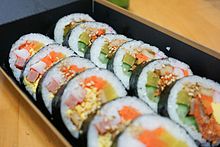紫菜包饭
外观
此条目可参照英语维基百科相应条目来扩充。 (2020年8月1日) |
| 紫菜包饭 | |
 一盘紫菜包饭切片 | |
| 朝鲜语名称 | |
|---|---|
| 谚文 | 김밥 |
| 文观部式 | gimbap |
| 马-赖式 | kimbap |
紫菜包饭(韩语:김밥,罗马化:gimbap,中国大陆称为紫菜包饭,香港称为紫菜卷饭,台湾称为海苔饭卷)[1],是一种流行的朝鲜食品[2],是将蒸熟的白米饭和各种其他材料卷进紫菜中,再切成一块块供应。[3]紫菜包饭通常在野餐或户外活动时吃,或作为简便的午餐,佐以萝卜干或泡菜。[4]

朝鲜日治时期,日本的卷寿司(巻き寿司)传入朝鲜半岛[5][6][7][8][9]。朝鲜人在日本寿司的基础上发展出紫菜包饭。虽然外型跟日本寿司卷相像,紫菜包饭在调味或制作上的主要差异存在于,一,紫菜包饭的海苔通常会用芝麻香油均匀的抹在上面以散发香味,二,米饭通常为原味而不会加醋调味。三,馅料日本多使用鱼肉,韩国则是以猪肉为主,并会加辣酱或泡菜等辛辣与腌渍食材,也因为馅料更多达三四种以上而明显比较粗。
小卷的紫菜包饭通常并不切片。另外紫菜包饭也有类似日式饭团的变种,称三角紫菜包饭(韩语:삼각김밥/三角김밥)。
紫菜包饭在韩国很便宜且容易买到,一般在韩国的小吃店等地中,1000至2000韩元左右就可以买到紫菜包饭。紫菜包饭品种众多,老少皆宜。所以很受东南亚地区人们的欢迎。
参考资料
[编辑]- ^ (韩语) 주요 한식명(200개) 로마자 표기 및 번역(영, 중, 일) 표준안 (PDF). 韩国国立国语院. 2014-07-30 [2017-02-15]. (原始内容存档 (PDF)于2019-01-23).
- ^ Kimbap (页面存档备份,存于互联网档案馆), excerpt from Andrew J. Luxner's American English: A Teachers's Journey in Seoul, South Korea. Golden Hill Books, San Diego. ISBN 0-9760748-1-8
- ^ Gimbap[失效链接], 斗山世界大百科(朝鲜文)
- ^ Gimbap 互联网档案馆的存档,存档日期2012-03-24., Encyclopedia of Korean Culture(朝鲜文)
- ^ Levinson, David; Christensen, Karen. Encyclopedia of Modern Asia: China-India relations to Hyogo. Charles Scribner's Sons. 2002 [2016-06-06]. ISBN 0-684-80617-7. (原始内容存档于2019-06-20).
This process was initiated during the Japanese occupation (1910-1945), when Western food and drink, such as bread, confectionery, and beer, became popular in Korean cities, and a Western-style food processing industry in Korea began. Some Japanese food items were also adopted into Korean cuisine at that time, such as tosirak (the assorted lunch box) and sushi rolled in sheets of seaweed, which was popular in Korea under the name of kimbap.
- ^ Brunner, Anne. Algas/ Algae: Sabores Marinos Para Cocinar/ Marine Flavors for Cooking. Editorial HISPANO EUROPEA. 2011 [2016-06-06]. ISBN 84-255-1977-2. (原始内容存档于2016-10-10) (西班牙语).
En Corea, los gimbaps son derivados de los maki sushis japoneses, pero generalmente están rellenos de arroz con aceite de sésamo y carne. [In Korea, gimbaps are derived from the Japanese maki sushi, but they are usually stuffed with rice with sesame oil and meat.]
- ^ 김밥 [Gimbap]. 한국민족문화대백과[Encyclopedia of Korean National Culture]. (原始内容存档于24 March 2012) (韩语).
일본음식 김초밥에서 유래된 것으로 [(Gimbap is) derived from Japanese norimaki]
- ^ 국립국어연구원 [National Institute of Korean languages]. 우리 문화 길라 잡이: 한국인 이 꼭 알아야할 전통 문화 233가지 [Guide To Our Culture: 233 kinds of Korean traditional culture for you to know]. 학고재 [Hakgojae]. 2002: 479 [2016-06-06]. ISBN 89-85846-97-3. (原始内容存档于2016-09-27) (韩语).
일본 음식인 김초밥 에서 유래 한 것으로 [(Gimbap is) derived from Japanese norimaki]
- ^ Gimbap. Ministry of Culture, Sports and Tourism Korea. (原始内容存档于2016年6月6日) (韩语).
일본음식에서 유래된 것으로 [(紫菜包饭)由日式食物演变而来 ]
